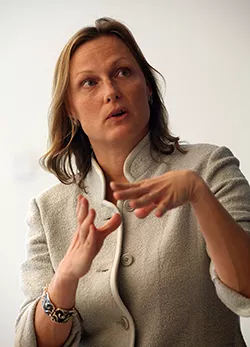Economist Amanda Bayer on Gender Gap in Economics

American Economic Association: Swarthmore's Amanda Bayer discusses sexism in the profession and what to do about it
The economics profession has a diversity problem.
It’s not a new problem. Yet, the profession’s gender imbalance has been a topic of intense debate lately.
A Berkeley undergraduate’s thesis on sexism in economics drew widespread media attention amid a broader conversation about the obstacles women face in male dominated industries like high tech.
Swarthmore professor Amanda Bayer has worked much of her career to address diversity in economics. She has published papers about it, served on the AEA’s Committee on the Status of Minority Groups in the Economics Profession, and co-organized a national summit on the topic with the Federal Reserve. She is also the creator and editor of Diversifying Economic Quality, a widely read online resource that promotes inclusive, innovative, and evidence-based teaching practices in economics.
She recently spoke with Chris Fleisher and Diana Schoder of the American Economic Association about the severity of the gender gap in economics, why addressing it is more than an issue of fairness, and her own experiences as she advanced her career.
Chris Fleisher: How significant is the gender gap in the economics profession?
Amanda Bayer: The gender disparities in the economics profession are striking. They start at the undergraduate level, if not before, continue through Ph.D. programs, and into the professorate. Well, let me have you guess. What percentage of econ majors at the undergraduate level do you think are female?
Fleisher: I would say maybe fewer than one-fourth?
Bayer: All right, so we do better than that. About 30 percent across all types of institutions of econ majors are female.
Fleisher: The disparity is even huge compared to other social science disciplines. Why is economics any different from any other discipline?
Bayer: That's a huge question, but I think it bears some time in just noting the fact that it is different. The percentage female at the undergraduate level in economics is well below the percentage female in other social sciences, in business, in humanities, and even below the percentage female in STEM fields. Economics is an outlier.
Diana Schoder: A lot of people talk about math being a big obstacle to entering economics. But based on what you just said about economics sliding behind even STEM fields and other math based or highly technical fields, why might economics have any differences?
Bayer: There's a huge misconception that it's the math component of economics that's keeping women away. And that's actually not the situation. About 45 percent of math majors at the undergraduate level are women. So, women major in math at a higher rate than they do in economics. Other studies with regression evidence show that math isn't the factor that explains the gap.
Bayer joined Swarthmore's faculty in 1992. Her research interests include microeconomics, game theory, labor markets, and discrimination. Each year, she teaches a course, Race, Ethnicity, and Gender in Economics, in which she uses economic theory and statistical tools to analyze the sources of social and economic inequality and examines the roles of race, ethnicity, and gender in the development of economic theory and policy, evaluating economic models and government policies as products of economic and cultural environments.



